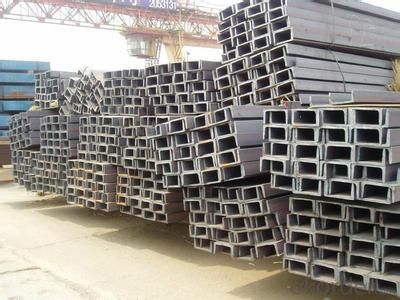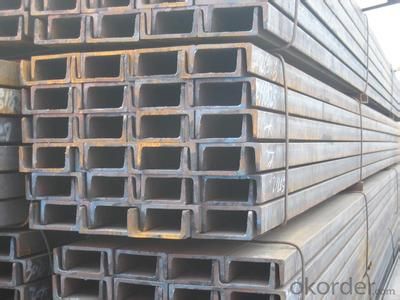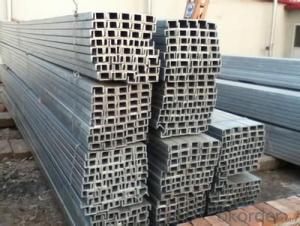U Channel Steel/Steel Channel Iron/Galvanized Steel Channel Dimensions
- Loading Port:
- Tianjin
- Payment Terms:
- TT OR LC
- Min Order Qty:
- 2000 PCS
- Supply Capability:
- 40000 PCS/month
OKorder Service Pledge
Quality Product, Order Online Tracking, Timely Delivery
OKorder Financial Service
Credit Rating, Credit Services, Credit Purchasing
You Might Also Like
U Channel Steel/Steel Channel Iron/Galvanized Steel Channel Dimensions Details
| Dimensions: | 5#-40#AB | Grade: | Q235,Q345/SS400, SM400A,SM400B | Place of Origin: | China (Mainland) |
| Certificate: | CQC | Model Number: | 5#-40# | Shape: | U Channel |
| Application: | manufacture and fabrication of a broad range of engineered products | Perforated Or Not: | Not Perforated | Standard: | GB,JIS,EN |
Packaging & Delivery
| Packaging Detail: | Standard export packing or as per your request |
| Delivery Detail: | 25-45 days |
U Channel Steel/Steel Channel Iron/Galvanized Steel Channel Dimensions Advantages
Full size
High quality
Prompt shipment
U Channel Steel/Steel Channel Iron/Galvanized Steel Channel Dimensions Specifications
Product | U channel steel | ||
| Standard | JIS AISI ASTM GB DIN BS | ||
| Grade | Q235,Q345/SS400,SM400A,SM400B,SPFC590 | ||
| Size | 50*37*4.5mm---400*104*14.5mm | ||
| Length | 6m,9m,12m,or cut the goods to the clients'request | ||
| Shape | U | ||
| Package | Standard export packing or as per your request | ||
| Application | Construction,shipbuilding,machine-made household industry | ||
U Channel Steel/Steel Channel Iron/Galvanized Steel Channel Dimensions Pictures


- Q:Can steel channels be welded?
- Certainly, welding is a viable option for joining steel channels. Renowned for their robustness and adaptability, steel channels find wide application in construction and manufacturing sectors. Welding serves as a prevalent approach to connect steel channels, enabling the formation of larger structures or alterations to preexisting ones. Through the welding process, the steel channel edges are melted, left to cool and solidify, thereby establishing a durable and enduring connection. Nevertheless, it is crucial to employ suitable welding techniques and guarantee meticulous preparation and cleansing of the steel surfaces to achieve a weld of superior quality.
- Q:What are the considerations for steel channel connections to steel beams?
- There are several important factors that need to be taken into account when considering connections between steel channels and steel beams. The first and most important factor is to ensure that the connection is structurally sound and capable of withstanding the intended loads and forces. This requires a thorough analysis of the design requirements, including the anticipated loads, the geometry of the channel and beam, and any applicable building codes or regulations. One factor to consider is the type of connection that will be used. Welding, bolting, or a combination of both are common options. The choice will depend on factors such as the strength requirements, the ease of installation, and any specific constraints or limitations imposed by the project. Another factor to consider is the connection detailing. This involves determining the specific dimensions, tolerances, and clearances required for the connection to ensure a proper fit and alignment. The detailing should also address any potential issues that may arise during fabrication, transportation, and erection, such as distortion or misalignment of the components. It is also important to consider the potential for corrosion and its impact on the connection. Steel channel connections to steel beams are susceptible to corrosion, especially in environments with high humidity, saltwater exposure, or chemical contaminants. To ensure the longevity and durability of the connection, proper corrosion protection measures, such as coatings, galvanization, or the use of corrosion-resistant materials, should be implemented. Additionally, the connection method should allow for any necessary adjustments or modifications. This is particularly important in cases where the channel may need to be repositioned or replaced in the future. The connection should be designed to allow for easy disconnection, reconnection, or adjustment without compromising the overall structural integrity. Lastly, it is crucial to consider the cost and time implications of the chosen connection method. Different connection methods have varying costs and installation times, and these factors should be carefully considered in relation to the project budget and schedule. In conclusion, the considerations for steel channel connections to steel beams involve structural integrity, connection type, detailing, corrosion protection, adjustability, and cost/time implications. By carefully addressing these factors, a reliable and efficient connection can be achieved, ensuring the overall stability and strength of the steel structure.
- Q:Are steel channels suitable for use in the construction of elevated storage systems?
- Yes, steel channels are suitable for use in the construction of elevated storage systems. Steel channels provide strength, durability, and stability, making them ideal for supporting heavy loads and withstanding the forces associated with elevated structures. Additionally, steel channels can be easily customized and are readily available, making them a practical choice for constructing elevated storage systems.
- Q:How do steel channels contribute to the overall material efficiency of a structure?
- Steel channels play a crucial role in enhancing the material efficiency of a structure. These structural elements are designed to provide strength and support to various structural components, optimizing the use of materials in a cost-effective manner. Firstly, steel channels are known for their high strength-to-weight ratio. This means that they can carry heavy loads while being relatively lightweight themselves. By utilizing steel channels, engineers can reduce the amount of material required to support the structure, resulting in a more efficient use of resources. This is particularly important in large-scale projects where reducing the overall weight of the structure can lead to significant cost savings. Moreover, steel channels offer versatility in terms of design and construction. Their uniform shape and standardized dimensions allow for easy integration into different structural systems. This reduces the need for custom fabrication and simplifies the construction process. As a result, the overall material efficiency of the structure is improved as there is minimal wastage of resources during the construction phase. Furthermore, steel channels contribute to the overall durability and longevity of the structure. Steel is known for its resistance to corrosion, fire, and other environmental factors. This ensures that the structure remains intact and functional for an extended period, reducing the need for frequent maintenance or replacement. By using steel channels, the overall lifecycle of the structure is increased, leading to improved material efficiency. In conclusion, steel channels play a vital role in enhancing the material efficiency of a structure. Their high strength-to-weight ratio, versatility in design, and durability contribute to reducing material usage, simplifying construction, and increasing the longevity of the structure. By incorporating steel channels into the structural design, engineers can optimize the use of materials, resulting in a more sustainable and cost-effective solution.
- Q:What are the load distribution factors for steel channel beams?
- The load distribution factors for steel channel beams depend on various factors, including the size and shape of the beam, the type of load being applied, and the overall structural design. Load distribution factors help determine how the load is distributed across the beam and its supporting structures. In general, steel channel beams have good load distribution characteristics due to their shape and structural properties. The shape of the channel beam, with its flanges and web, provides stability and enhances load distribution capabilities. Factors such as the span length, the type and magnitude of the load, and the support conditions at both ends of the beam play a crucial role in determining the load distribution factors. For example, a shorter span length generally results in a more uniform distribution of the load, while longer spans may require additional supports or reinforcements to ensure proper load distribution. The type of load being applied, whether it is a concentrated load or a distributed load, also affects the load distribution factors. Concentrated loads, such as those from machinery or equipment, require careful consideration to ensure that the load is evenly distributed across the beam and does not cause localized stress concentrations. Additionally, the design of the supporting structures, such as columns or walls, influences the load distribution factors. Properly designed connections between the beam and its supports help transfer the load efficiently and distribute it evenly throughout the structure. It is important to consult with structural engineers or reference design codes and standards to determine the specific load distribution factors for a given steel channel beam. These factors can vary depending on the specific application and design requirements, and it is crucial to ensure that the beam is designed and installed in accordance with industry standards to ensure safe and efficient load distribution.
- Q:What are the different connection methods for steel channels?
- There are several different connection methods for steel channels, depending on the application and desired structural integrity. Some of the most common connection methods include: 1. Welding: This is a popular method for connecting steel channels. Welding involves melting the edges of the channels and fusing them together using heat. It provides a strong and durable connection, but it requires skilled welders and can be time-consuming. 2. Bolting: Bolting is another common method for connecting steel channels. It involves using bolts and nuts to secure the channels together. This method is relatively quick and easy, and it allows for disassembly if needed. However, it may not provide as strong a connection as welding. 3. Riveting: Riveting is a method where metal pins or rivets are used to join the steel channels together. This technique is commonly used in heavy-duty applications and offers a strong and permanent connection. However, it requires special tools and skilled labor to perform. 4. Adhesive bonding: Adhesive bonding involves using high-strength adhesives or epoxy to join steel channels together. This method can provide a strong and flexible connection, but it may not be suitable for all applications and requires appropriate surface preparation and curing time. 5. Mechanical connectors: Mechanical connectors, such as beam hangers or brackets, can be used to connect steel channels. These connectors provide a quick and easy method for joining channels, but they may not offer the same level of structural integrity as other methods. It's important to consider factors such as load bearing capacity, structural design requirements, and ease of installation when choosing a connection method for steel channels. Consulting with a structural engineer or a construction professional can help ensure the appropriate connection method is selected for a specific project.
- Q:What are the different types of surface finishes for steel channels in architectural applications?
- There are several different types of surface finishes that can be used for steel channels in architectural applications. These finishes not only enhance the aesthetic appeal of the steel channels but also provide protection against corrosion and wear. Here are some common types of surface finishes for steel channels: 1. Mill Finish: This is the basic finish that steel channels have when they are initially manufactured. It has a dull gray appearance and is typically rough in texture. Mill finish steel channels are often used in industrial applications where aesthetics are not a primary concern. 2. Hot-Dip Galvanized: This finish involves dipping the steel channels into a bath of molten zinc, creating a thick layer of zinc coating on the surface. Hot-dip galvanized steel channels have a shiny, silver appearance and provide excellent corrosion resistance, making them suitable for outdoor architectural applications. 3. Powder Coating: Powder coating is a popular surface finish for steel channels in architectural applications. It involves applying a dry powder to the surface and then heating it to form a durable, protective layer. Powder coating provides a smooth, even finish and is available in a wide range of colors, allowing for customization and design flexibility. 4. Stainless Steel: Steel channels can also be fabricated from stainless steel, which inherently provides a corrosion-resistant finish. Stainless steel channels have a sleek, modern appearance and are often used in architectural designs that require a high-end, polished finish. 5. Painted Finish: Steel channels can be painted with various types of paint to achieve a desired color and finish. Painted finishes offer versatility and can be customized to match the architectural design. However, they may require periodic maintenance to prevent chipping or fading. 6. Brushed or Polished Finish: Brushed or polished finishes involve mechanically abrading the steel channels to create a smooth, reflective surface. These finishes are commonly used in architectural applications where a high-quality, decorative appearance is desired. Each type of surface finish for steel channels in architectural applications has its own characteristics and advantages. The choice of finish depends on factors such as the desired appearance, level of corrosion resistance required, and the specific environmental conditions the steel channels will be exposed to.
- Q:The telescopic arm is welded by channel steel and steel plate. Then the channel steel is inclined and the guide is not good enough. Is it a special profile? What are the telescopic arms?
- Steel welding steel mostly used as a beam or a column, the steel plate is relatively thick, and the channel has been forming calculation immunity anti disturbance capability is greatly improved, two only in the center position of weld line position, the formation of the moment theory on the bending of the analysis should be small and therefore, whether it is welding crack or welding deformation can better handle. In no case have to supply square, to be.
- Q:How do steel channels perform under dynamic loads?
- Steel channels are known for their high strength and load-bearing capacity, making them well-suited for handling dynamic loads. When subjected to dynamic loads, such as vibrations, impacts, or fluctuating forces, steel channels exhibit excellent performance and durability. The structural design of steel channels allows them to effectively distribute dynamic loads throughout their length, preventing localized stress concentrations. This characteristic minimizes the risk of fatigue failure, which is crucial in applications where repeated loading occurs. Steel channels also possess good stiffness, which helps to maintain their shape and integrity under dynamic loads. This stiffness allows them to resist bending, twisting, or deforming, ensuring the overall stability and safety of the structure. Additionally, steel channels are highly ductile, meaning they can withstand significant deformation without fracturing. This ductility is essential in absorbing and dissipating energy during dynamic loading events, such as impacts or earthquakes, reducing the risk of catastrophic failure. Furthermore, steel channels are often used in conjunction with other structural components, such as bolts, welds, or connectors, to enhance their load-bearing capacity. The combination of steel channels with these reinforcements further improves their performance under dynamic loads by increasing their resistance to shear, torsion, and bending forces. In summary, steel channels are well-suited for handling dynamic loads due to their high strength, excellent load distribution capabilities, stiffness, ductility, and compatibility with reinforcements. These qualities make them a reliable choice for various applications that require withstanding dynamic forces, ensuring the durability and safety of the structures they are used in.
- Q:Can steel channels be used for creating signage or display structures?
- Indeed, signage or display structures can be fashioned using steel channels. These channels, due to their versatility and durability, are appropriate for a multitude of purposes, including signage and display structures. Their robustness and inflexibility enable the construction of resilient frameworks that can endure harsh outdoor conditions and substantial burdens. Furthermore, steel channels can be effortlessly personalized and manufactured into diverse configurations and dimensions, thus catering to particular design prerequisites. Consequently, they represent an exemplary option for crafting extraordinary and attention-grabbing signage or display structures.
1. Manufacturer Overview |
|
|---|---|
| Location | |
| Year Established | |
| Annual Output Value | |
| Main Markets | |
| Company Certifications | |
2. Manufacturer Certificates |
|
|---|---|
| a) Certification Name | |
| Range | |
| Reference | |
| Validity Period | |
3. Manufacturer Capability |
|
|---|---|
| a)Trade Capacity | |
| Nearest Port | |
| Export Percentage | |
| No.of Employees in Trade Department | |
| Language Spoken: | |
| b)Factory Information | |
| Factory Size: | |
| No. of Production Lines | |
| Contract Manufacturing | |
| Product Price Range | |
Send your message to us
U Channel Steel/Steel Channel Iron/Galvanized Steel Channel Dimensions
- Loading Port:
- Tianjin
- Payment Terms:
- TT OR LC
- Min Order Qty:
- 2000 PCS
- Supply Capability:
- 40000 PCS/month
OKorder Service Pledge
Quality Product, Order Online Tracking, Timely Delivery
OKorder Financial Service
Credit Rating, Credit Services, Credit Purchasing
Similar products
New products
Hot products
Related keywords



























